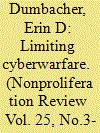| Srl | Item |
| 1 |
ID:
150079


|
|
|
|
|
| Summary/Abstract |
This analysis considers a controversy over whether the 1925 Geneva Protocol, the treaty prohibiting the use of chemical and biological weapons in warfare, covered CS “tear gas.” Widespread deployment of tear gases by American forces in Vietnam after 1964 attracted much international criticism as many believed the Protocol banned such agents and pressure gradually built on the British government to clarify its interpretative position. Its tabling a disarmament initiative to prohibit production and possession of biological weapons in July 1969 exacerbated the situation, provoking allegations of diverting attention from chemical weapons as a favour to America and the “Special Relationship.” Meanwhile, the outbreak of the “troubles” in Northern Ireland earlier the same year, where British forces also used CS, presented further difficulties. Britain rejected inclusion of CS under the Protocol in February 1970 but wrestled at great length over the decision and its consequences under the Harold Wilson and Edward Heath governments. Largely absent from historical accounts, this episode allows an examination of a complex, convoluted issue that had potentially wide-ranging ramifications for the interpretation of international relations and treaties. Similarly, re-creating confidential inter-departmental decision-making processes, particularly comparing scientific and legal interpretations, the processes of governmental bureaucracy and the role played by civil society demonstrates why an element with little immediate linkage to British overseas affairs proved such a conundrum.
|
|
|
|
|
|
|
|
|
|
|
|
|
|
|
|
| 2 |
ID:
162680


|
|
|
|
|
| Summary/Abstract |
An arms race in cyberspace is underway. US and Western government efforts to control this process have largely been limited to deterrence and norm development. This article examines an alternative policy option: arms control. To gauge whether arms-control models offer useful lessons for addressing cyber capabilities, this article compiles a new dataset of predominantly twentieth-century arms-control agreements. It also evaluates two case studies of negotiated agreements that regulate dual-use technologies, the 1928 Geneva Protocol prohibiting chemical- and biological-weapon use and the 1944 Chicago Convention on International Civil Aviation. The analysis underscores the limits of norm development for emerging technologies with both civilian and military applications. It finds lessons for developing verifiable, international cooperation mechanisms for cyberwarfare in the regulatory model of international aviation. Conventionally, arms-control agreements take advantage of transparent tests or estimates of arms. To restrict cyberwarfare activities, experts and policy makers must adapt arms-control models to a difficult-to-measure technology at an advanced stage of development and use. Further investigation of international regulatory schemes for dual-use technology of similar diffusion and development to the internet, such as international civil aviation, is needed.
|
|
|
|
|
|
|
|
|
|
|
|
|
|
|
|